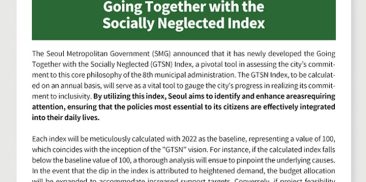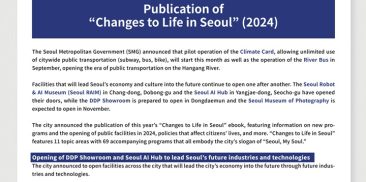特別号
-
2024 May (Vol.98)
-
特別号 登録日投稿者SMG ヒット558

Seoul Unveils Results of ‘2023 Seoul Survey’, Declaring Hangang River as Seoul’s Landmark!
- Results of the ‘Seoul Survey,’ conducted on 20,000 households in Seoul, reveal various aspects of life and society
- Seoul’s landmark is the ‘Hangang River’ for citizens and ‘Gwanghwamun Square’ for international residents in the city; ‘Easy transportation’ is the most attractive feature of the city at citizens’ poll
- Satisfaction with leisure activities gradually increases each year: 60.6 percent prefer ‘parks’ for relaxation and leisure
According to a survey, Seoulites consider the Hangang River, and international residents see Gwanghwamun Square as the city’s landmark. Additionally, Seoul citizens identified convenient transportation and a wide array of food and shopping channels as the city’s charm.
Since 2003, Seoul has been designing essential policies and projects based on the citizen survey, aiming to improve citizens’ quality of life and its competitiveness. The survey, targeting a total of 20,000 households, covers various aspects of life for its citizens and international residents, including low birth rates, an aging population, and digitalization.
Gwanghwamun Square Seoul’s landmark is the ‘Hangang River’ for citizens and ‘Gwanghwamun Square’ for international residents in the city; ‘Easy transportation’ is the most attractive feature of the city for the citizens
First, it was revealed that the top landmark for citizens in Seoul is the ‘Hangang River.’ Following closely behind are Gwanghwamun Square, palaces, and N Seoul Tower, ranking 2nd to 4th respectively. There has been a shift in their perceptions of landmarks over the past decade, with the Hangang River moving from 4th place in the 2010 survey to 1st place, while the former 1st place holder, palaces, dropping to 3rd.
Regarding the question about Seoul’s charm, convenient transportation ranked first in terms of ‘accessibility,’ while ‘convenience’ saw diverse shopping and food options ranking high.
The satisfaction with leisure activities has been gradually increasing, with 35.5% reporting that they have achieved a balance between work and leisure
Seoul citizens agree on the importance of leisure activities, although their daily lives focus more on work (6.44 points in 2021 to 6.51 points in 2023). They concentrate on work until their 30s and 40s, gradually increasing their leisure activities from their 50s.
While feeling somewhat lacking in the time allocated for leisure activities, satisfaction with leisure activities has gradually increased (5.27 points in 2020 to 5.70 points in 2023). Additionally, the response indicating ‘achieving a good balance’ (35.3%) was the most common when asked about balancing work and leisure.
During weekends and holidays, respondents desired outdoor activities, such as travel, outings, and exercise (71.0%). Still, in reality, outdoor activities (outings/travel & exercise, 51.3%) and indoor activities (watching videos & computer games, 52.7%) were balanced.
For ‘relaxation and leisure activities (60.6%),’ Seoul citizens visit parks, with two out of three also spending their leisure time near rivers and waterways
Seoul citizens visit parks for relaxation (42.8%), leisure activities (17.8%), health promotion (17.0%), and enjoying nature (14.1%). Parks are also utilized as spaces to foster valuable relationships with family and friends.
In the past six months, 88.5% of respondents visited parks, with the most frequently visited types being small parks near their homes (82.8%), forests including trails and forest paths (52.3%), and large parks (47.5%). Particularly, small parks near homes were frequented by over 80% of all age groups, showing high visitation rates.
In addition to parks, rivers, including waterfront areas, serve as spaces for leisure activities for two out of three Seoul citizens (68.6%). Rivers are utilized for activities such as walking, strolling, cycling, and exercise, promoting health and fostering social connections.
The percentage of respondents who are ‘satisfied’ with green environments such as parks and forests within a 15-minute walk increased from 46.1% in 2021 to 51.6% in 2023, with the satisfaction score for green environments reaching 6.31 points, an increase from 5.99 points in 2021.
How to download report data
○ Seoul Open Data Plaza (http://data.seoul.go.kr)
– Report:▸Open Data Plaza ▸Statistics ▸Seoul Statistical Publications ▸Urban Policy Index Survey (Seoul Survey) ▸2024 ▸2023 Seoul Survey Report
– Source Material (Micro data): ▸Open Data Plaza ▸Search ‘Seoul Survey’









